Sites: news | india | latam | brasil | indonesia
Feeds: news | india | latam | brasil | indonesia
topic: Solar Power
Social media activity version | Lean version
Bangladesh island’s switch from solar power to fossil fuels threatens birds
- The Bangladesh government recently converted off-grid Nijhum Dwip Island in the Bay of Bengal into an on-grid locality powered by fossil fuel-fired plants, posing a threat to the country’s second-largest mangrove forest.
- The island’s inhabitants had depended on individual solar-run power, and the government planned to install a mini solar grid for an uninterrupted power supply a few years back.
- Instead, the government has facilitated the construction of a 15 megawatt heavy-fuel-run power plant at Hatiya, the subdistrict headquarters of Nijhum Dwip, under the ‘100% Reliable and Sustainable Electrification Project,’ which seems to be a reverse transition from renewable to fossil fuel-based electrification.
- Nature conservationists believe that due to the connection to the national grid, human activities will increase around the forest and endanger the already cornered wildlife of the national park on the island.
Rocky rollout for Bangladesh’s ambitious solar-powered irrigation plans
- Nearly half of irrigation costs in Bangladesh are due to irrigation, and the diesel pumps that currently power irrigation networks are responsible for 1.6% of the country’s greenhouse gas emissions.
- To address both issues, the government is rolling out a nationwide program to gradually replace these diesel pumps with solar-powered ones, aiming to slash irrigation-related emissions by 0.8 million metric tons by 2030.
- It also says that given that irrigation use is concentrated in the non-monsoon months, the surplus energy generated by the pumps the rest of the time can be fed into the grid, providing up to 480 gigawatt-hours of clean energy a year.
- In pilot programs, however, farmers have expressed concern over the reliability of the solar pump systems, especially for water-intensive crops such as rice and corn, and have also noted that their irrigation costs remain the same.
We need a better understanding of how crops fare under solar panels, study shows
- In agrivoltaics, farmers grow crops beneath or between solar panels.
- Proponents say the technology can help achieve clean energy goals while maintaining food production, but experts caution that careful analysis and guidelines are needed if we’re not to compromise agricultural production.
- A new synthesis of previously published studies finds that overall crop yields decline as the amount of land covered by solar panels increases.
- This ground cover ratio is a convenient, easily measured and reproducible metric that can be used to predict crop yields and better evaluate agrivoltaic systems.
A lithium ‘gold mine’ is buried under one of Europe’s last heritage farming systems
- The hilly Barroso region of northern Portugal has been recognized for its centuries-old and “globally important” farming system that combines agricultural biodiversity, resilient ecosystems and a valuable cultural heritage.
- But the region is also home to what’s believed to be one of Europe’s largest deposits of lithium, an element that will be critical in the ongoing clean energy transition, with EU and Portuguese officials saying mining projects in Barroso will be key to securing domestic supplies of the metal.
- Residents and environmental activists, however, warn the mines will scar the landscape, contaminate the water, erode the soil, disrupt local livelihoods, and deprive them of communal lands.
- Yet even as they continue to oppose the planned mines, the state can declare lithium projects to be of strategic public interest to force residents to lease the lands needed for the mining projects.
Floating solar project on Philippines natural lake brings hope — and questions
- Laguna Lake in the Philippines is home to a pilot project for a floating solar photovoltaic (FPV) installation that could provide energy to surrounding communities as the country faces pressure to transition away from fossil fuels.
- “Floatovoltaic” installations already exist in other parts of Asia, but none are currently on natural lakes like Laguna; researchers say further research is needed to determine the long-term effects on the environment and local communities.
- In Laguna, local fishing communities hope their voices are heard as the project develops, especially since their livelihoods could be affected by the FPV installations; however, the project could also bring new jobs to the area.
Electricity day and night: Solar power is changing isolated Amazon communities
- The Amazon region produces more than a quarter of the energy in Brazil. Still, hundreds of thousands of families are off the grid and rely on expensive diesel generators to produce electricity.
- Solar panels and other renewable energies can greatly improve the lives of people in these regions and help create jobs.
- NGOs and governments have implemented renewable energy plans in different communities in the Amazon with positive results.
- Experts agree that public policies to provide electricity in the region should also be designed to help generate new sources of income for these communities.
Bangladeshi industries explore renewables as power crisis looms
- Although Bangladesh achieved 100% access to electricity for all people in March 2022, dwindling gas reserves, alongside a jump in global prices of Liquefied Natural Gas (LNG), have forced the Bangladesh government to resort to power load-shedding.
- Since July 2021, the production of natural gases has drastically fallen. Against a demand of 2,252 million cubic feet of gas for power generation, only 1,035 million cubic feet of gas has been supplied to the power plants in recent months.
- Ready-made garment factories (RMGs) are not convinced the government will be able to ensure uninterrupted power supply to their establishments if the crisis prolongs.
- Some factories are trying to set up their own solar plants to avoid dependence on fossil fuel-based power. Solar installations require both heavy investment and space and thus only large factories can afford to do it at present.
Sluggish growth of renewables threatens Bangladesh’s clean-energy goals
- The development of renewable energy in Bangladesh continues to be outpaced by non-renewables such as coal, gas and nuclear.
- This threatens the country’s ability to meet both its commitment to reduce greenhouse gas emissions under the Paris Agreement, and its goal under the U.N. SDGs of ensuring that at least 10% of energy consumption by 2030 comes from renewable sources.
- Renewables today account for just 2% of the power flowing into the grid, or 3.49% of total consumption if off-grid sources are included.
- While the country is embarking on a spate of renewable energy projects, including one solar and four wind farms, these are overshadowed by the seven coal plants, 13 gas plants, and one — possibly two — nuclear plants in the works.
Mongabay’s What-To-Watch list for March 2022
- In February, Mongabay covered agroforestry among Costa Rica’s Indigenous people, deforestation in the Brazilian Amazon, the environmental problems of human sewage, and the unanticipated downsides of the solar energy sector in India.
- Watch a rare video where chimpanzees are seen being medical practitioners, and how dedicated rangers are protecting endangered apes in the forests along the Nigeria-Cameroon border.
- Get a peek into the various segments of the environment across the globe. Add these videos to your watchlist for the month and watch them for free on YouTube.
At a disputed Native massacre site, tribes brace for a new, lithium-driven rush
- The U.S. Bureau of Land Management has approved an open-pit lithium ore mine in northern Nevada, despite protests by Native tribes to protect the disputed sacred site.
- Lithium is in high demand as the key component in batteries that fuel electric vehicles and cellphones, raising environmental concerns about its extraction.
- The U.S. government is ramping up production of lithium all along the domestic supply chain to meet its clean energy goals.
In the Brazilian Amazon, solar energy brings light — and new opportunities
- A village on the banks of Brazil’s Negro River is running 132 solar panels as part of a pilot project aimed at bringing clean energy and economic opportunity to remote communities in the Amazon.
- The scheme promises to bring reliable energy to the community of Santa Helena do Inglês, in northern Amazonas state, addressing frequent power cuts that have long plagued the remote village and thwarted efforts to develop sustainable income streams.
- The solar energy supply is helping the community — a former logging hub that now lies within a protected reserve — generate income from fishing and ecotourism, without encroaching on the forest.
Cooking with the sun: Entrepreneurs help launch Mexico’s solar revolution
- Much of Mexico gets 300 days of sunshine out of the year which is helping make the country a solar energy pioneer. With the current government showing little interest in the clean sustainable technology, a range of entrepreneurs is leading the way, especially in the food industry.
- In the southern state of Oaxaca, Victoria Aguilera studied sustainable energy at the regional university and founded Sazón del Sol, a grassroots project that includes a solar farm, solar restaurant, and solar food processing workplace. She designed and now sells a solar kitchen for use in homes and restaurants.
- In central Mexico’s Hidalgo state, Gregor Schäpers’ company, Trinysol, achieved initial success with solar-powered water heaters. Now he’s experimenting with solar cooking using Scheffler modules — solar dish reflectors to run kitchens in restaurants, hotels, mezcal distilleries and tortilla bakeries.
- In the state of Jalisco, Angel Mejía and Aldo Agraz co-founded Inventive Power in 2010, specializing in thermal solar systems. Local food factories and dairies were their first clients. Since then, Mexican and international companies Nestlé, Barcel, Unilever, and tequila producer José Cuervo have all commissioned projects.
Coal phase-out plan gets pushback in power-hungry Indonesia
- Officials and industry in Indonesia have questioned a plan by the national utility to phase out all coal-fired power plants, while clean energy advocates have welcomed the proposal.
- The main objections to the plan include the high cost of prematurely retiring coal-fired power plants that haven’t achieved a return on investment, and the persistently high price of renewable energy compared to coal in Indonesia.
- Supporters of the plan say it’s not just economically feasible, but over the long term would work out cheaper than maintaining coal plants, while creating millions of jobs in the renewable energy sector.
- A glaring inconsistency in the plan, however, is that the utility is at the same time also planning to bring 117 under-construction and planned coal-fired power plants online, negating any notion of a “phase-out.”
Indonesia says no new coal plants from 2023 (after the next 100 or so)
- Indonesia plans to stop building new coal-fired plants after 2023, with additional electrical capacity to be generated only from new and renewable sources.
- Development experts and the private sector have welcomed the plan, but some say it’s not ambitious enough since it still entails construction of new coal plants that have already been signed.
- Once these plants are built, they will operate for decades to come, and their emissions will spell disaster for climate change.
- There’s also controversy over what the government considers “new and renewable” energy, in which it lumps solar and wind alongside biomass, nuclear, and gasified coal.
Melina Laboucan-Massimo: Catalyzing an Indigenous-led just energy transition
- A Just Transition is the idea that the shift toward low-carbon economies needs to be fair and inclusive, meaning it considers the people that will be most impacted by abandoning fossil fuels.
- Among the groups most likely to be affected by the green energy transition are Indigenous communities, many of whom may be disproportionately dependent on fossil fuels for their day-to-day energy needs and livelihoods, and at the same time are also most likely to bear the brunt of the impacts of climate change.
- Recognizing the need for a Just Transition for Indigenous Peoples, Melina Miyowapan Laboucan-Massimo of the Lubicon Cree First Nation in northern Alberta founded Sacred Earth Solar in 2015 to empower Indigenous communities across Canada to adopt renewable energy.
- Laboucan-Massimo spoke about catalyzing a just energy transition for Indigenous peoples, the legacy of colonization, and more, during a March 2021 conversation with Mongabay founder Rhett Ayers Butler.
Indian embassy in Madagascar becomes first to go fully solar
- A solar power plant was inaugurated at the Indian embassy in Antananarivo, Madagascar, to mark the 150th birth anniversary of Mahatma Gandhi on October 2.
- It became the first Indian embassy in the world to be run entirely on solar power from the 8 KW plant.
- Madagascar has huge potential to develop solar energy, with almost all regions receiving 2800 hours of sunshine in a year.
- The environment minister acknowledged that with less than 15% of people having access to grid electricity embracing solar power was a way for Madagascar to develop and meet its climate goals.
Analysis: Vietnam’s leadership flex shows how to drive electricity reform
- Vietnam’s Communist Party leadership has instituted a top-down reform of the country’s electricity sector in response to the need to shift away from coal and its growing list of associated problems.
- The country’s new energy strategy puts greater emphasis on renewables, including wind and solar, abandoning a decade-long commitment to investing in and subsidizing coal.
- The move is also helped by recent technological developments that have made generating renewable power at scale more economically feasible than ever.
Analysis: Floating solar power along the dammed-up Mekong River
- This year, the first floating solar power generating system in Southeast Asia was deployed on a reservoir in Vietnam.
- Floating solar power systems are being written into the energy master plans of Singapore, Thailand, Indonesia and the Philippines as well as Vietnam, and into the calculations of investment banks.
- The technology presents an alternative to additional hydroelectric power projects.
New UN report takes stock of renewable energy’s decade-long growth spurt
- 2018 was the ninth year in a row in which renewable energy capacity investments exceeded $200 billion and the fifth year in a row in which they exceeded $250 billion, according to a report released by the UN ahead of the Climate Action Summit to be held in New York City later this month.
- That means that, by the time it’s over, the current decade — 2010 to 2019 — will have seen a total of $2.6 trillion in renewable energy investments and a four-fold increase in global renewable energy capacity (excluding large hydroelectric dams, i.e. those with electricity generation capacity of 50 megawatts or more).
- Of all the major generating technologies, including those that burn fossil fuels, solar accounts for 638 GW of new power capacity installed since 2010, the largest single share claimed by any technology. Coal-fired power comes in second at 529 GW, wind in third at 487 GW, and gas in fourth at 438 GW.
Carbon to burn: UK net-zero emissions pledge undermined by biomass energy
- The United Kingdom and the European Union are setting goals to achieve net-zero carbon emissions by 2050. But that declaration is deeply flawed, analysts say, due to a long-standing United Nations carbon accounting loophole that turns a blind eye toward the conversion of coal burning power plants to burning wood pellets.
- While the cutting of trees to convert them to wood pellets to produce energy is ultimately carbon neutral — if an equal number of new trees are planted — the regrowth process requires 50 to 100 years. That means wood pellets burned today, and in coming decades, will be adding a massive carbon load to the atmosphere.
- That carbon will add significantly to global warming — bringing more sea level rise, extreme weather, and perhaps, climate catastrophe — even as official carbon counting by the UN provides a false sense of security that we are effectively reducing emissions to curb climate change.
- Unless the biomass loophole is dealt with, the risk is very real that the world could easily overshoot its Paris Agreement targets, and see temperatures rise well above the 1.5 degrees Celsius safe limit. At present, there is no official move to address the biomass loophole.
Shift to renewable energy could have biodiversity cost, researchers caution
- Climate change has widely reported negative consequences, and innovations in renewable energy technologies are central to achieving the Paris climate treaty goals to mitigate these effects.
- A new report cautions that mining of metals used in manufacturing renewable technologies like wind turbines, solar power, and electric vehicles has costs, including for biodiversity.
- Negative effects from the mining of metals like aluminum, cobalt and rare earths could impact a range of creatures from flamingoes to gorillas, plants, and even deep sea creatures.
- Until widespread recycling and reuse of these materials becomes a feasible alternative to mining, these activities should be monitored and verified via certification schemes such as the Initiative for Responsible Mining Assurance, researchers say.
Changing energy use in rural Africa with power from solar, clean stoves…and women
- Widespread use of fuelwood and charcoal for cooking and heating is a notable barrier to achieving development and conservation goals in sub-Saharan Africa, yet previous attempts at introducing better fuel technologies have largely failed.
- To address energy use at the source, recent efforts are underway that seek to improve adoption of new technologies, such as solar-powered equipment or efficient cookstoves, in rural communities.
- Rather than impose a new method or technology onto a community, encouraging behavior change by wrapping the technology in a collaborative or entrepreneurial envelope could encourage longer-lasting change.
Conceived in a dream, new solar canoe will serve Amazon tribes
- A solar-powered canoe, just the second of its kind, is scheduled for launch around April 20 in the village of Sharamentsa on the Pastaza River in the Ecuadorean Amazon.
- The canoe is part of a project that aims to connect nine remote indigenous communities through an alternative transportation system powered by the sun and channeled by Amazon rivers.
- The launch coincides with the comeback of the first canoe, which has been grounded by technical problems, and the opening of a solar community center in Sharamentsa that will function as a canoe-recharging station and will eventually provide power to the village.
- Project leaders intend to build similar solar centers in other villages that, along with the canoes, will ultimately form a large energy and transportation network powered by sunlight.
With no oil cleanup in sight, Amazon tribes harvest rain for clean water
- The Siona, Secoya and Kofan indigenous peoples have been living with the consequences of oil drilling in Ecuador’s northeastern Sucumbíos province for several generations.
- Many communities say the oil industry has polluted their sources of water for drinking, cooking and bathing, with grave consequences for their health.
- With the communities, the Ecuadoran government and the U.S. oil company Chevron locked in legal battle over who will pay for a cleanup, and oil still being pumped from beneath the rainforest, the communities are now forging a path around their pollution problems.
- Indigenous communities, with help from a U.S. NGO, have installed more than 1,100 rainwater collection and filtration systems in 70-plus villages to supply clean water. They’ve also set up dozens of solar panels to ensure ample electricity that does not rely on the fossil fuel industry they say has irreparably harmed their home and way of life.
COP24: Nations complicit in ignoring bioenergy climate bomb, experts say
- Twenty years ago science told policymakers that bioenergy – the burning of woody biomass – was a sustainable form of energy that was carbon neutral. The current United Nations carbon accounting system follows that guidance. However, new science has found the hypothesis to be wrong: bioenergy has been found to add significantly to carbon emissions.
- However, national delegations at the UN climate summit in Poland, COP24, as they wordsmith the Paris Rulebook, are stonewalling on the matter, doing nothing to close the bioenergy carbon accounting loophole. But nature can’t be fooled, which means that the undercounting of emissions could push the world past a climate catastrophe tipping point.
- Still, with the problem unaddressed, developed nations in the European Union and elsewhere continue burning woody biomass as energy, with the U.S., Canada and other nations happy to profit from the accounting error. Tropical nations like Brazil and Peru are eager to jump on the bioenergy bandwagon, a potential disaster for rainforests and biodiversity.
- Meanwhile, NGOs and scientists at COP24 have sought earnestly to alert the media and COP delegations to the bioenergy climate bomb and its looming risks, even going so far as to write language closing the loophole that could be inserted into the Paris Rulebook now being negotiated, but to no avail.
‘Light for everyone’: Indigenous youth mount a solar-powered resistance
- Among the cloud forests of northern Puebla, Mexico, an indigenous cooperative is training its youth to install solar panels.
- The initiative was born of the cooperative’s contentious fight with the federal and local government over plans to build an electricity substation that the co-op members believed would only benefit industry, not local communities.
- The panels are part of a plan hatched by these mountain communities to unhook from Mexico’s federal power company, provide their youth with meaningful employment, and reclaim control of their land and resources.
- The initiative appears to be well aligned with the renewable-energy plans of Mexico’s new president, Andrés Manuel López Obrador.
On an island in the sun, coal power is king over abundant solar
- Locals and environmentalists have opposed a plan to expand a coal-fired power plan in northern Bali, Indonesia.
- They are worried that the expansion will exacerbate the existing impact of the plant on the environment and locals’ health and livelihoods.
- A particular concern focuses on the survival of dolphins and endemic species living in close proximity to the plant, with Greenpeace saying the dolphins have particularly been affected since the plant came on line in 2015.
- Another major worry is air pollution, with many locals complaining of respiratory ailments as a result of the fumes and coal dust emitted from the plant.
UN forest accounting loophole allows CO2 underreporting by EU, UK, US
- Emissions accounting helps determine whether or not nations are on target to achieve their voluntary Paris Agreement reduction goals. Ideally, the global community’s CO2 pledges, adjusted downward over time, would, taken together, help keep the world from heating up by 1.5 degrees Celsius (2.7 degrees Fahrenheit) by 2100 from a 1900 baseline.
- But scientists are raising the alarm that this goal may already be beyond reach. One reason: a carbon accounting loophole within UN Intergovernmental Panel on Climate Change (IPCC) guidelines accepting the burning of wood pellets (biomass) as a carbon neutral replacement for coal — with wood now used in many European Union and United Kingdom power plants.
- Scientists warn, however, that their research shows that replacing coal with wood pellets in power plants is not carbon neutral. That’s partly because burning wood, which is celebrated by governments as a renewable and sustainable energy resource, is less efficient than coal burning, so it actually produces more CO2 emissions than coal.
- Also, while wood burning and tree replanting over hundreds of years will end up carbon neutral, that doesn’t help right now. Over a short timeframe, at a historical moment when we require aggressive greenhouse gas reductions, wood burning is adding to global emissions. Analysts say that this loophole needs to be closed, and soon, to avoid further climate chaos.
Red Cloud’s Revolution: Oglalla Sioux freeing themselves from fossil fuel
- Henry Red Cloud, like so many Oglalla Sioux young men, left the reservation to work in construction. When he returned home in 2002, he needed a job, and also wanted to make a difference. He attended a solar energy workshop and saw the future.
- Today, Red Cloud runs Lakota Solar and the Red Cloud Renewable Energy Center, which have become catalysts for an innovative new economic network – one that employs locals and connects tribes, while building greater energy independence among First Nations.
- The company is building and installing alternative energy systems, and training others to do the same, throughout remote areas of U.S. reservations, thus allowing the Sioux and others to leap past outdated fossil fuel technology altogether.
- Henry Red Cloud’s company has another more radical purpose: it helps provide energy to remote Water Protector camps, like the one at Standing Rock protesting the Dakota Access Pipeline (DAPL). Solar power and other alternative energy sources are vital at such remote sites, as they power up cellphones, connecting resistors to the media and outside world.
Powering cameras and empowering people
- Keeping equipment running in harsh field conditions can challenge any tech project, as can working successfully with volunteers.
- Mongabay-Wildtech spoke with leaders of one project, wpsWatch, that deploys connected camera traps to monitor wildlife and people in reserves and employs volunteers to monitor image feeds from afar.
- Powering equipment for field surveillance and “making it part of everyone’s day” enable the rapid image detection, communication, and response by ground patrols needed to successfully apprehend wildlife poachers using cameras and other sensors.
Even as Trump and Modi clash on energy, India and U.S. are partnering
- In the past, and under Pres. Trump and Prime Minister Modi, the U.S. and India have often been at odds environmentally, especially regarding climate change, with the U.S. saying that developing nations need to do more to cut emissions, while India says that the U.S, as biggest historical carbon emitter, must take a primary role.
- However, the two countries, under Obama and now under Trump, have quietly done trade agreements to enhance the transfer of liquid natural gas and nuclear power plant technology via sales from U.S. high tech companies to India.
- India’s Modi, a proponent of solar energy, was also convinced in talks with Pres. Obama to be a big supporter of the Paris Climate Agreement. Though, with the ascendance of Pres. Trump, and his rejection of the landmark accord, the two countries have again parted ways.
- Trump’s plan to renege on a US $2 billion Green Climate Fund (GCF) commitment made by Pres. Obama could somewhat slow India’s drive to quickly embrace green technologies.
Temer uses controversial deforestation data in speech to UN
- In his speech to the 72nd General Assembly of the United Nations in New York on Monday, Brazil’s president Michel Temer referred to preliminary data showing reduced deforestation that critics say may not be accurate.
- Critics also refute other aspects of his speech, including his touting of Brazil’s renewable energy movement. Hydropower is the country’s largest source of renewable energy, which scientists say can have a huge carbon footprint.
- A protest comprised of representatives from more than 150 organizations gathered in Brasilia on Tuesday in reaction to Temer’s speech.
Renewable energy to power 139 countries? Scientists say it’s possible
- The research looked at the impacts of a 100-percent switch to renewable energy in 139 countries by 2050 on the climate, as well as air pollution and the economy.
- They calculated that the transition to wind, solar and hydropower will generate around 24 million net jobs.
- Switching to renewable sources of energy that don’t emit carbon into the atmosphere will also save trillions of dollars in the costs we would otherwise incur due to air pollution and the changing climate.
People of all faiths face climate change with hope, action, urgency
- Pope Francis gave Trump a copy of his encyclical on global environmental protection during the president’s visit to Europe in May. A week later Trump pulled out of the Paris Climate Agreement.
- While the majority of U.S. Catholics voted for Trump, and polled less favorably toward the pope after publication of Laudato Si, his bold plea to save the earth continues to energize leaders of all faiths.
- Examples abound: in May, 55 “emerging faith leaders” from 17 countries met in Brazil to identify realistic renewable energy and sustainability projects for their nations. Also in May, nine large Catholic organizations from around the globe announced divestment from coal, oil and gas stocks.
- Hindu spiritual leaders are urging the jettisoning of coal for alternative energy, and reducing pollution around temples. Morocco committed to converting 15,000 mosques to renewable energy by 2019. Jordan spiritual leaders have committed to going solar. Change could be faster, many agree, but it is ongoing.
From black gold to wind and solar: How China is turning its back on coal
- Coal helped power China’s industrial boom, but at a heavy price: the country is now the world’s largest carbon emitter and many cities suffer dangerous pollution levels.
- Economic changes and policies that take into account pollution and climate change are driving a shift away from coal.
- China’s coal consumption has fallen for three consecutive years.
Investors learning to pay heed to community land rights
- Most conflicts besetting private investments in Africa – 63 percent – relate to pushing people off their lands.
- These conflicts affect agriculture, mining, and even green energy investments.
- In Southern Africa, 73 percent of conflicts turned violent and 73 percent halted work on the developments.
The week in environmental news – Feb 05, 2016
- Experts say the Zika virus public health crisis comes with an important message regarding how humans are altering their environment.
- One of 14 new tarantula species recently described by biologists, was named after Johnny Cash for being located near the Folsom Prison and being all black in color.
- A recent study reports that Europe’s shift away from lighter-colored broad-leafed trees to dark green conifers has stoked global warming.
Solar energy boom has put natural areas at risk
- Study found that most big solar installations in California were located in biologically-sensitive desert lands — comprising of scrublands and shrublands — for installations, covering about 145 square miles.
- Nearly one-third of the big solar installations were located in crop lands, the team found.
- Study also identified around 8,500 square miles of areas in less-sensitive, already-developed land that is compatible for solar energy installations.
How solar thermal curbs pollution and improves health
 GoSol.org’s work in Mexico Modern environmental crises of global resources often threaten both human health as well as biodiversity. Many of these concerns have consistently escaped remediation by public health institutions and mainstream environmental organizations. The compounding severity of these threats requires solutions that are cheap, local, scalable, easily replicated and immediately beneficial to local […]
GoSol.org’s work in Mexico Modern environmental crises of global resources often threaten both human health as well as biodiversity. Many of these concerns have consistently escaped remediation by public health institutions and mainstream environmental organizations. The compounding severity of these threats requires solutions that are cheap, local, scalable, easily replicated and immediately beneficial to local […]
EPA carbon proposal may be crucial step in addressing global climate change
 The U.S. Environmental Protection Agency’s (EPA) June 2nd regulation proposal hit all the expected chords. Following on the heels of a January regulation for new power plants, the Clean Power Plan focuses on all existing electric generation. By 2030, the plan aims to reduce 2005-level carbon dioxide emissions by 30 percent and soot and smog-causing […]
The U.S. Environmental Protection Agency’s (EPA) June 2nd regulation proposal hit all the expected chords. Following on the heels of a January regulation for new power plants, the Clean Power Plan focuses on all existing electric generation. By 2030, the plan aims to reduce 2005-level carbon dioxide emissions by 30 percent and soot and smog-causing […]
Climate fail: Geoengineering would cool planet, but screw up rainfall patterns
 For decades, scientists have been grappling with the consequences of climate change and working toward viable solutions. Climate engineering, also known as geoengineering, is the most controversial possible solution. Currently, one of the most talked about geoengineering ideas is Solar Radiation Management (SRM), which intends to block shortwave solar radiation, thus cooling the Earth to […]
For decades, scientists have been grappling with the consequences of climate change and working toward viable solutions. Climate engineering, also known as geoengineering, is the most controversial possible solution. Currently, one of the most talked about geoengineering ideas is Solar Radiation Management (SRM), which intends to block shortwave solar radiation, thus cooling the Earth to […]
Solar Photovoltaic Projects: In the Mainstream Power Market – book review
 Solar Photovoltaic Projects: In the Mainstream Power Market, written by renewables energy pioneer Philip Wolfe, is an excellent introduction to the solar photovoltaic project development and power markets sector. Mr. Wolfe’s multi-decadal experience in the solar sector first founding BP Solar in the 1970s and then later working with various renewable energy finance initiatives, brings […]
Solar Photovoltaic Projects: In the Mainstream Power Market, written by renewables energy pioneer Philip Wolfe, is an excellent introduction to the solar photovoltaic project development and power markets sector. Mr. Wolfe’s multi-decadal experience in the solar sector first founding BP Solar in the 1970s and then later working with various renewable energy finance initiatives, brings […]
Looking bright: solar power passes 100 gigawatts worldwide
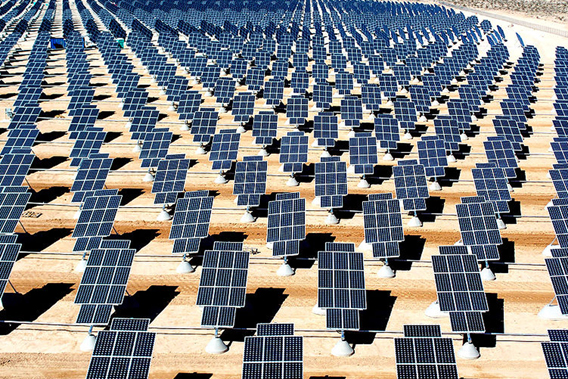 Solar power on Nellis Air Force Base in Nevada. Photo by: U.S. Air Force photo/Airman 1st Class Nadine Y. Barclay. The world’s installed solar capacity hit 101 gigawatts last year, according to new data from the European Photovoltaic Industry Association (EPIA). Last year alone, saw nearly 30 gigawatts of solar power added around the world. […]
Solar power on Nellis Air Force Base in Nevada. Photo by: U.S. Air Force photo/Airman 1st Class Nadine Y. Barclay. The world’s installed solar capacity hit 101 gigawatts last year, according to new data from the European Photovoltaic Industry Association (EPIA). Last year alone, saw nearly 30 gigawatts of solar power added around the world. […]
New wind power cheaper than coal or gas in Australia
 Electricity supplied from a new wind farm is cheaper than that from a new gas or coal-fired power plant in Australia, reports a new analysis published by Bloomberg New Energy Finance. According to the study, wind-generated electricity costs AU$80 ($83) per megawatt hour compared with compared to AU$143/MWh ($148) from a new coal plant or […]
Electricity supplied from a new wind farm is cheaper than that from a new gas or coal-fired power plant in Australia, reports a new analysis published by Bloomberg New Energy Finance. According to the study, wind-generated electricity costs AU$80 ($83) per megawatt hour compared with compared to AU$143/MWh ($148) from a new coal plant or […]
Could marine cloud machines cool the planet?
 In 1990, British cloud physicist John Latham published a paper arguing he could cool global climate by brightening clouds over the ocean. Most colleagues ignored the paper, titled “Control global warming?”—probably because this thing called global warming was not yet a hot topic. Now, more than two decades later, Latham continues to develop what has […]
In 1990, British cloud physicist John Latham published a paper arguing he could cool global climate by brightening clouds over the ocean. Most colleagues ignored the paper, titled “Control global warming?”—probably because this thing called global warming was not yet a hot topic. Now, more than two decades later, Latham continues to develop what has […]
Will we need to pull carbon out of the atmosphere to save ourselves?
 The ongoing decline in Arctic sea ice hit a new record this year that rocked even the most pessimistic predictions. The low sea ice extent hit 18 percent below the previous record set in just 2007, and was only around half the size it was in 1980. Here, NASA satellites catches a glimpse of the […]
The ongoing decline in Arctic sea ice hit a new record this year that rocked even the most pessimistic predictions. The low sea ice extent hit 18 percent below the previous record set in just 2007, and was only around half the size it was in 1980. Here, NASA satellites catches a glimpse of the […]
Tigers vs. coal in India: when big energy meets vanishing cats
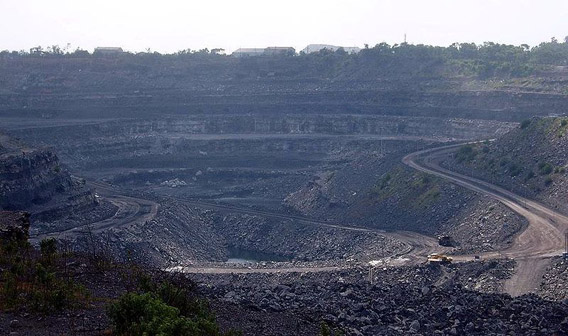 Surface coal mining in Bihar, India. Around 70-80 percent of India’s power is currently provided by coal. Burning coal fuels climate change, causes acid rain, and spreads toxic pollutants into the environment, but now a new Greenpeace report warns that coal may also imperil the world’s biggest feline: the tiger. Home to world’s largest population […]
Surface coal mining in Bihar, India. Around 70-80 percent of India’s power is currently provided by coal. Burning coal fuels climate change, causes acid rain, and spreads toxic pollutants into the environment, but now a new Greenpeace report warns that coal may also imperil the world’s biggest feline: the tiger. Home to world’s largest population […]
Solar cells cross new threshold
 Imagine powering your cell phone by leaving it on the window sill. Sounds like science fiction? Actually, this might soon turn into reality. Scientists have been exploring the potential of solar energy for decades. One of the cheapest ways to turn solar energy into electricity is by creating solar cells from organic polymers, which are […]
Imagine powering your cell phone by leaving it on the window sill. Sounds like science fiction? Actually, this might soon turn into reality. Scientists have been exploring the potential of solar energy for decades. One of the cheapest ways to turn solar energy into electricity is by creating solar cells from organic polymers, which are […]
Germany proves the promise of renewable energy: hits 20 percent renewables
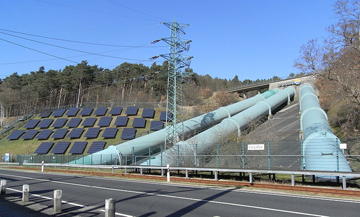 As many people in the United States question whether renewable energy is a viable alternative to fossil fuels, Germany now derives 20.8 percent of its electricity from renewable sources—a 15 percent increase since 2000, reports Der Spiegel. In contrast, the United States generates only 10 percent of its electricity from renewable sources, 6 percent of […]
As many people in the United States question whether renewable energy is a viable alternative to fossil fuels, Germany now derives 20.8 percent of its electricity from renewable sources—a 15 percent increase since 2000, reports Der Spiegel. In contrast, the United States generates only 10 percent of its electricity from renewable sources, 6 percent of […]
Clean energy investments rise 630% in 7 years
According to a report by the US Pew Environment Group global clean energy investments, which do not include nuclear power, jumped 630% since 2004. The report detailing 2010 clean energy investments found that China remains the global leader in clean energy, while the US fell from 2nd to 3rd. This is the second year in […]
Is Obama’s clean energy revolution possible?
 Recent studies point to the feasibility of a global clean energy revolution. Last night US President Barack Obama called for a massive green energy make-over of the world’s largest economy. Describing the challenge as ‘this generation’s Sputnik moment’ the US president set a goal of producing 80 percent of America’s energy by clean sources by […]
Recent studies point to the feasibility of a global clean energy revolution. Last night US President Barack Obama called for a massive green energy make-over of the world’s largest economy. Describing the challenge as ‘this generation’s Sputnik moment’ the US president set a goal of producing 80 percent of America’s energy by clean sources by […]
U.S. Department of Energy makes $1.5B loan to massive solar plant
 The U.S. Department of Energy has finalized a guarantee to provide a loan of $1.45 billion to Abengoa Solar Inc. which will fund the world’s largest parabolic trough concentrating solar plant. The plant is expected to serve 70,000 households and avoid 475,000 tons of carbon dioxide emissions per year. The plant, called Solana, will be […]
The U.S. Department of Energy has finalized a guarantee to provide a loan of $1.45 billion to Abengoa Solar Inc. which will fund the world’s largest parabolic trough concentrating solar plant. The plant is expected to serve 70,000 households and avoid 475,000 tons of carbon dioxide emissions per year. The plant, called Solana, will be […]
Bill Gates: larang batu bara dan berinvestasi di teknologi energi bersih
Planet membutuhkan “keajaiban energi” untuk mengatasi tantangan ganda dari memenuhi permintaan energi dan mengatasi perubahan iklim, ujar penemu Microsoft Bill Gates dalam pidato Jumat di Konferensi TED di Long Beach, California. “Yang akan harus kita lakukan dalam skala global adalah menciptakan sistem baru,” ungkap Gates. “Sehingga kita membutuhkan keajaiban energi.” Hanya beberapa minggu setelah yayasannya […]
Bill Gates: ban coal and invest in clean energy technology
The planet needs “energy miracles” to overcome the dual challenges of meeting energy demand and addressing climate change, said Microsoft founder Bill Gates during a speech Friday at the TED Conference in Long Beach, California. “What we’re going to have to do at a global scale is create a new system,” Gates said. “So we […]
Could special bonds fund the green revolution and stabilize the climate?
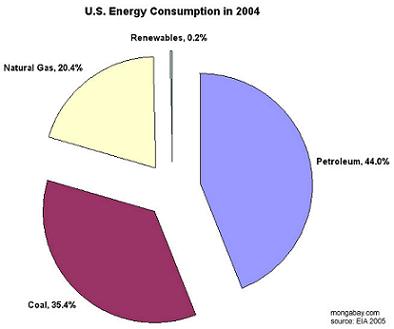 There is no question that governments around the world are moving slowly and sluggishly to combat climate change, especially when placed against the measures recommended by climate scientists. Only a handful of nations have actually cut overall greenhouse gas emissions, and the past couple decades have seen emissions rise rapidly worldwide as nations like India […]
There is no question that governments around the world are moving slowly and sluggishly to combat climate change, especially when placed against the measures recommended by climate scientists. Only a handful of nations have actually cut overall greenhouse gas emissions, and the past couple decades have seen emissions rise rapidly worldwide as nations like India […]
China leaves US (and Europe) in the dust on renewable energy
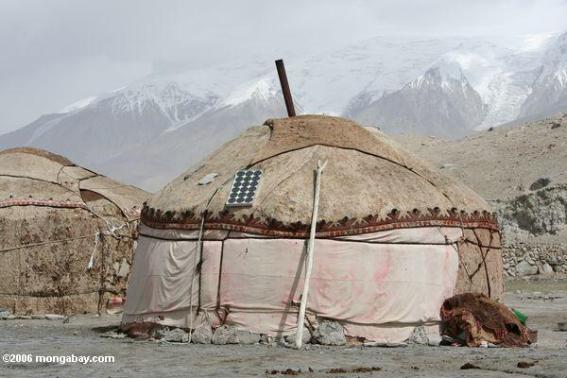 This year China has become the world’s largest manufacturer of solar panels and wind turbines, doubling its wind capacity since 2005. The economically booming nation—and the world’s most populous—has also invested heavily in nuclear power and the world’s most efficient coal plants, according to the New York Times. Still, even with massive investments in green […]
This year China has become the world’s largest manufacturer of solar panels and wind turbines, doubling its wind capacity since 2005. The economically booming nation—and the world’s most populous—has also invested heavily in nuclear power and the world’s most efficient coal plants, according to the New York Times. Still, even with massive investments in green […]
US subsidies of oil and coal more than double the subsidies of renewable energy
 During the fiscal years of 2002-2008 the United States handed out subsidies to fossil fuel industries to a tune of 72 billion dollars, while renewable energy subsidies, during the same period, reached 29 billion dollars. Conducted by the Environmental Law Institute (ELI) in partnership with the Woodrow Wilson International Center for Scholars, the research shows […]
During the fiscal years of 2002-2008 the United States handed out subsidies to fossil fuel industries to a tune of 72 billion dollars, while renewable energy subsidies, during the same period, reached 29 billion dollars. Conducted by the Environmental Law Institute (ELI) in partnership with the Woodrow Wilson International Center for Scholars, the research shows […]
Solar powered conservation

Will ‘peak oil’ spur expanded coal use? And what does it mean for climate?
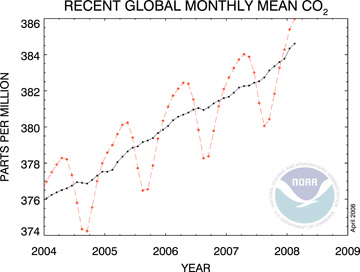 Whether oil is succeeded by coal or renewables will have major impact on climate The world must phase out emissions from coal by 2030 to avert dangerous climate change, said scientists speaking at the annual meeting of the American Geophysical Union in San Francisco. Arguing that the planet will face environmental constraints well before fossil […]
Whether oil is succeeded by coal or renewables will have major impact on climate The world must phase out emissions from coal by 2030 to avert dangerous climate change, said scientists speaking at the annual meeting of the American Geophysical Union in San Francisco. Arguing that the planet will face environmental constraints well before fossil […]
Living up to the Pope’s words: the Vatican turns to solar power
Living up to the Pope’s words: the Vatican turns to solar power Living up to the Pope’s words: the Vatican turns to solar power Jeremy Hance, mongabay.com November 28, 2008
Obama may bring leadership, rather than obstruction, to climate change talks
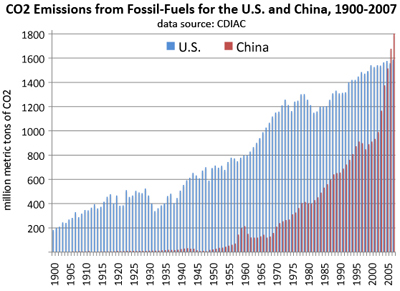 Obama may bring leadership, rather than obstruction, to climate change talks Obama may bring leadership, rather than obstruction, to climate change talks mongabay.com November 6, 2008
Obama may bring leadership, rather than obstruction, to climate change talks Obama may bring leadership, rather than obstruction, to climate change talks mongabay.com November 6, 2008
U.S. Congress passes legislation to boost solar, wind, and geothermal energy
U.S. Congress passes legislation to boost solar, wind, and geothermal energy U.S. Congress passes legislation to boost solar, wind, and geothermal energy mongabay.com September 24, 2008 Tuesday the U.S. Senate passed a bill that will extend tax credits on solar power installations through 2016. The House approved the measure Wednesday. The $17 billion package will […]
PG&E will build the world’s largest solar power plant
 PG&E will build the world’s largest solar power plant PG&E will build the world’s largest solar power plant mongabay.com August 15, 2008 California electricity producer PG&E Thursday announced a plan to build two giant solar photovoltaic power plants that will cover 12.5 square miles and have a peak generating capacity of 800 megawatts. The plants […]
PG&E will build the world’s largest solar power plant PG&E will build the world’s largest solar power plant mongabay.com August 15, 2008 California electricity producer PG&E Thursday announced a plan to build two giant solar photovoltaic power plants that will cover 12.5 square miles and have a peak generating capacity of 800 megawatts. The plants […]
Gore launches second campaign… for Earth
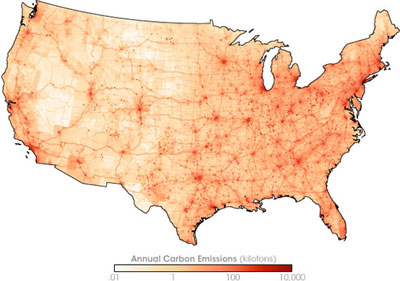 Gore launches second campaign… for Earth Gore launches second campaign mongabay.com July 17, 2008 In a speech Thursday, Al Gore challenged the U.S. to generate 100 percent of its electricity from zero carbon emission sources within 10 years. Speaking at Washington’s Constitution Hall, Gore said America’s security, environmental and economic crises are all related, and […]
Gore launches second campaign… for Earth Gore launches second campaign mongabay.com July 17, 2008 In a speech Thursday, Al Gore challenged the U.S. to generate 100 percent of its electricity from zero carbon emission sources within 10 years. Speaking at Washington’s Constitution Hall, Gore said America’s security, environmental and economic crises are all related, and […]
Breakthrough in solar energy: ten times more effective solar power may be available in three years
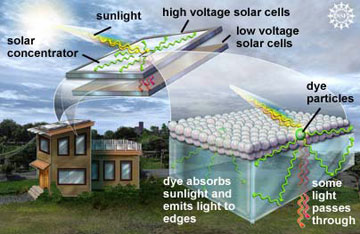 Breakthrough in solar energy: ten times more effective solar power may be available in three years Breakthrough in solar energy: ten times more effective solar power may be available in three years Jeremy Hance, mongabay.com July 10, 2008 The breakthrough scientists have been waiting for to make solar power cheaper, more efficient–and therefore a more […]
Breakthrough in solar energy: ten times more effective solar power may be available in three years Breakthrough in solar energy: ten times more effective solar power may be available in three years Jeremy Hance, mongabay.com July 10, 2008 The breakthrough scientists have been waiting for to make solar power cheaper, more efficient–and therefore a more […]
Clean energy gold rush in 2007
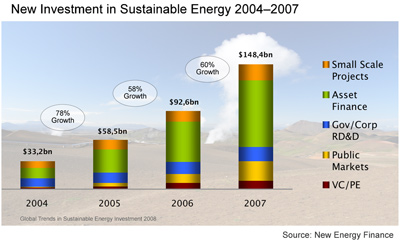 Clean energy investments rose 60% to $148 billion in 2007 Clean energy gold rush in 2007 mongabay.com July 1, 2008 New investment in renewables and energy efficiency surpassed $148 billion in 2007, rising 60 percent rise from 2006, according to an analysis issued Tuesday July 1 by the UN Environment Programme (UNEP). High oil prices […]
Clean energy investments rose 60% to $148 billion in 2007 Clean energy gold rush in 2007 mongabay.com July 1, 2008 New investment in renewables and energy efficiency surpassed $148 billion in 2007, rising 60 percent rise from 2006, according to an analysis issued Tuesday July 1 by the UN Environment Programme (UNEP). High oil prices […]
California plan would cut emissions 30% by 2020
California plan would cut emissions 30% by 2020 California plan would cut emissions 30% by 2020 mongabay.com June 27, 2008 California announced a plan to reduce state greenhouse gas emissions by 30 percent by 2020. The measures include a cap and trade program covering 85 percent of the state’s emissions, incentives for utilities to generate […]
94% of Americans support solar energy development
94% of Americans support solar energy development 94% of Americans support solar energy development mongabay.com June 11, 2008 94 percent of Americans say it’s important for the U.S. to develop and use solar energy, according to a new poll that found support for solar power runs across the political spectrum. The SCHOTT Solar BarometerTM survey, […]
Arizona seeks to become the ‘Persian Gulf’ of solar energy
Arizona seeks to become the ‘Persian Gulf’ of solar energy Arizona seeks to become the ‘Persian Gulf’ of solar energy mongabay.com February 22, 2008 With a Spanish company’s plans to dramatically expand solar capacity in the desert southwest of Phoenix, Arizona Governor Janet Napolitano said Arizona could become the “Persian Gulf of solar energy,” according […]
New World Record for Solar-to-Grid Conversion Efficiency
 New World Record for Solar-to-Grid Conversion Efficiency New World Record for Solar-to-Grid Conversion Efficiency mongabay.com February 13, 2008 Sandia National Laboratories and Stirling Energy Systems (SES) set a new solar-to-grid system conversion efficiency record by achieving a 31.25 percent net efficiency, nearly a 2 point gain of the previous record of 29.4 percent set in […]
New World Record for Solar-to-Grid Conversion Efficiency New World Record for Solar-to-Grid Conversion Efficiency mongabay.com February 13, 2008 Sandia National Laboratories and Stirling Energy Systems (SES) set a new solar-to-grid system conversion efficiency record by achieving a 31.25 percent net efficiency, nearly a 2 point gain of the previous record of 29.4 percent set in […]
Google aims to make renewable energy sources cheaper than coal
 Google aims to make renewable energy sources cheaper than coal Google aims to make renewable energy cheaper than coal mongabay.com November 28, 2007 Tuesday Google announced an initiative to develop electricity from renewable energy sources that will be cheaper than electricity produced from coal. The initiative, dubbed RE<C, will initially focus on solar, wind, and […]
Google aims to make renewable energy sources cheaper than coal Google aims to make renewable energy cheaper than coal mongabay.com November 28, 2007 Tuesday Google announced an initiative to develop electricity from renewable energy sources that will be cheaper than electricity produced from coal. The initiative, dubbed RE<C, will initially focus on solar, wind, and […]
IBM finds recycling can cut solar cell manufacturing costs
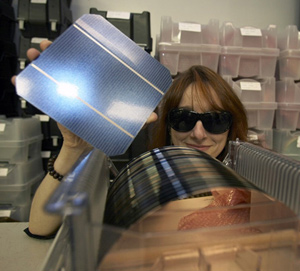 IBM finds recycling can cut solar cell manufacturing costs IBM finds recycling can cut solar cell manufacturing costs mongabay.com October 30, 2007 IBM today announced a silicon wafer recycling system that could help ease the refined silicon shortage that has driven up production costs of solar energy panels. The process allows efficient removal intellectual property […]
IBM finds recycling can cut solar cell manufacturing costs IBM finds recycling can cut solar cell manufacturing costs mongabay.com October 30, 2007 IBM today announced a silicon wafer recycling system that could help ease the refined silicon shortage that has driven up production costs of solar energy panels. The process allows efficient removal intellectual property […]
Florida to cut greenhouse gas emissions 80% by 2050
 Florida to cut greenhouse gas emissions 80% by 2050 Florida to cut greenhouse gas emissions 80% by 2050 mongabay.com July 15, 2007 Florida plans to cut greenhouse gas emissions 80 percent from 1990 levels by 2050 according to Charlie Crist, Florida’s Republican state governor. Due to its low elevation and hurricane risk, global warming may […]
Florida to cut greenhouse gas emissions 80% by 2050 Florida to cut greenhouse gas emissions 80% by 2050 mongabay.com July 15, 2007 Florida plans to cut greenhouse gas emissions 80 percent from 1990 levels by 2050 according to Charlie Crist, Florida’s Republican state governor. Due to its low elevation and hurricane risk, global warming may […]
Inflatable concentrators may cut cost of solar below conventional power plants
 Inflatable concentrators may cut cost of solar below conventional power plants Inflatable concentrators may cut cost of solarbelow conventional power plants Rhett A. Butler, mongabay.com July 8, 2007 Cool Earth Solar, a Livermore, California-based company developing an innovative way for capturing solar energy, has merged with Radiant Energy, a developer and owner of renewable and […]
Inflatable concentrators may cut cost of solar below conventional power plants Inflatable concentrators may cut cost of solarbelow conventional power plants Rhett A. Butler, mongabay.com July 8, 2007 Cool Earth Solar, a Livermore, California-based company developing an innovative way for capturing solar energy, has merged with Radiant Energy, a developer and owner of renewable and […]
Cuba Energy Crisis Solved
 Cuban Energy Crisis Solved Cuba Energy Crisis Solved By Joshua S Hill July 5, 2007 Cuba may be overcoming its intermittent energy crisis, according to a top U.N. official. Power shortages and brownouts have long been a problem in the small communist island nation, but it was daily 16 hour-electricity cuts in 2004 that finally […]
Cuban Energy Crisis Solved Cuba Energy Crisis Solved By Joshua S Hill July 5, 2007 Cuba may be overcoming its intermittent energy crisis, according to a top U.N. official. Power shortages and brownouts have long been a problem in the small communist island nation, but it was daily 16 hour-electricity cuts in 2004 that finally […]
Google to be carbon neutral by year end
 Google to be carbon neutral by year end Google to be carbon neutral by year end mongabay.com June 20, 2007 Google Inc. aims to be carbon neutral by the end of 2007, according to a statement posted on the Official Google Blog. The search giant plans to fight global warming by investing in and using […]
Google to be carbon neutral by year end Google to be carbon neutral by year end mongabay.com June 20, 2007 Google Inc. aims to be carbon neutral by the end of 2007, according to a statement posted on the Official Google Blog. The search giant plans to fight global warming by investing in and using […]
$100 billion invested in renewable energy in 2006
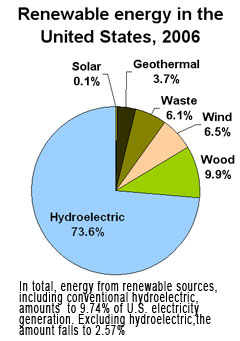 $100 billion invested in renewable energy in 2006 $100 billion invested in renewable energy in 2006 mongabay.com June 20, 2007 $100 billion poured into renewable energy and energy efficiency in 2006, a 25 percent jump from 2005, reports a new analysis by the UN Environment Programme (UNEP). UNEP anticipates the trend will slow to $85 […]
$100 billion invested in renewable energy in 2006 $100 billion invested in renewable energy in 2006 mongabay.com June 20, 2007 $100 billion poured into renewable energy and energy efficiency in 2006, a 25 percent jump from 2005, reports a new analysis by the UN Environment Programme (UNEP). UNEP anticipates the trend will slow to $85 […]
Google will put $10M towards plug-in hybrid cars
 Google will put $10M towards plug-in hybrid cars Google will put $10M towards plug-in hybrid cars Rhett A. Butler, mongabay.com June 19, 2007 Google.org, Google Inc.’s philanthropic arm, unveiled an initiative to convert hybrid cars to plug-in hybrid vehicles (PHEVs), a move that will cut carbon dioxide emissions, reduce oil use, and help stabilize the […]
Google will put $10M towards plug-in hybrid cars Google will put $10M towards plug-in hybrid cars Rhett A. Butler, mongabay.com June 19, 2007 Google.org, Google Inc.’s philanthropic arm, unveiled an initiative to convert hybrid cars to plug-in hybrid vehicles (PHEVs), a move that will cut carbon dioxide emissions, reduce oil use, and help stabilize the […]
Largest Solar Thermal Power Plant Built in 16 Years Goes Online
Largest Solar Thermal Power Plant Built in 16 Years Goes Online Largest Solar Thermal Power Plant Built in 16 Years Goes Online SCHOTT North America press release June 8, 2007 SCHOTT today announced that with the connection of the Nevada Solar One power plant to the grid, its solar receivers officially began collecting solar radiation […]
Nobel prize winner debates future of nuclear power
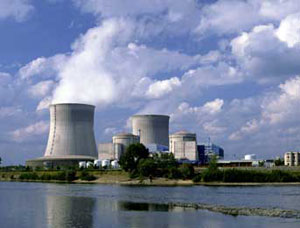 Nobel prize winner debates future of nuclear power Nobel prize winner debates future of nuclear power Rhett A. Butler, mongabay.com June 7, 2007 Two renowned energy experts sparred in a debate over nuclear energy Wednesday afternoon at Stanford University. Amory Lovins, Chairman and Chief Scientist of the Rocky Mountain Institute, an energy think tank, argued […]
Nobel prize winner debates future of nuclear power Nobel prize winner debates future of nuclear power Rhett A. Butler, mongabay.com June 7, 2007 Two renowned energy experts sparred in a debate over nuclear energy Wednesday afternoon at Stanford University. Amory Lovins, Chairman and Chief Scientist of the Rocky Mountain Institute, an energy think tank, argued […]
Device uses solar energy to convert CO2 into fuel
Device uses solar energy to convert CO2 into fuel Device uses solar energy to convert CO2 into fuel mongabay.com April 18, 2007 Chemists at the University of California, San Diego, (UCSD) have devised a device that uses solar energy to convert carbon dioxide into fuel. While the machine is only a prototype and not yet […]
Concentrating solar power better option than nuclear
Concentrating solar power better option than nuclear Concentrating solar power better option than nuclear Comment from Dr Gerry Wolff April 10, 2007 Comment regarding Nuclear power plants are financially risky given high costs: Nuclear power plants are risky investments given rapidly rising costs of construction of nuclear fuel, reports a new study by researchers from […]
Balloon technology could cut cost of solar energy 90% by 2010
 Balloon technology could cut cost of solar energy 90% by 2010 Balloon technology could cut cost of solar energy 90% by 2010 Rhett A. Butler, mongabay.com February 21, 2007 With high energy prices and mounting concerns over human-induced climate change, there is intense interest in renewable energy, especially solar, which produces no pollution and is […]
Balloon technology could cut cost of solar energy 90% by 2010 Balloon technology could cut cost of solar energy 90% by 2010 Rhett A. Butler, mongabay.com February 21, 2007 With high energy prices and mounting concerns over human-induced climate change, there is intense interest in renewable energy, especially solar, which produces no pollution and is […]
China to build world’s largest solar power plant
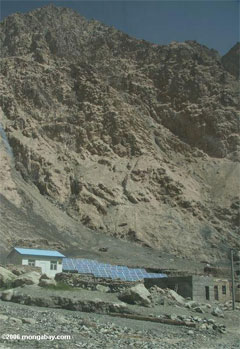 China to build world’s largest solar power plant China to build world’s largest solar power plant mongabay.com November 21, 2006 China plans to build the world’s largest solar power station in the northwestern province of Gansu according to a report from Xinhua, China’s state news agency. Construction of the 100 megawatt facility will take five […]
China to build world’s largest solar power plant China to build world’s largest solar power plant mongabay.com November 21, 2006 China plans to build the world’s largest solar power station in the northwestern province of Gansu according to a report from Xinhua, China’s state news agency. Construction of the 100 megawatt facility will take five […]
Google worried about global warming?
 Google worried about global warming? Google worried about global warming? Google to build largest solar-powered office in the U.S. mongabay.com October 17, 2006 Google said it plans to build a solar-powered electricity system at its Silicon Valley headquarters that will be the largest solar installation on any corporate campus in the United States. “Soon we […]
Google worried about global warming? Google worried about global warming? Google to build largest solar-powered office in the U.S. mongabay.com October 17, 2006 Google said it plans to build a solar-powered electricity system at its Silicon Valley headquarters that will be the largest solar installation on any corporate campus in the United States. “Soon we […]
Solar Energy Powers Mainland China’s Richest Man
 Solar Powers Makes Mainland China’s Richest Man Solar Energy Powers Mainland China’s Richest Man mongabay.com October 12, 2006 The largest private fortune in mainland China may belong to Shi Zhengrong, the founder of the China’s largest producer of photovoltaic equipment used to convert sunlight into electricity, according to an article in today’s edition of The […]
Solar Powers Makes Mainland China’s Richest Man Solar Energy Powers Mainland China’s Richest Man mongabay.com October 12, 2006 The largest private fortune in mainland China may belong to Shi Zhengrong, the founder of the China’s largest producer of photovoltaic equipment used to convert sunlight into electricity, according to an article in today’s edition of The […]
Northern Ireland madantes green energy for new buildings
 Northern Ireland mandates green energy for new buildings Northern Ireland mandates green energy for new buildings Northern Ireland Office July 25, 2006 Green buildings may be the future for Northern Ireland The Government is proposing changes to the Building Regulations which will make the use of renewable energy compulsory in all new builds from 2008, […]
Northern Ireland mandates green energy for new buildings Northern Ireland mandates green energy for new buildings Northern Ireland Office July 25, 2006 Green buildings may be the future for Northern Ireland The Government is proposing changes to the Building Regulations which will make the use of renewable energy compulsory in all new builds from 2008, […]
High school students compete in solar car race
 High school students compete in solar car race High school students compete in solar car race Modified news release from SCHOTT July 13, 2006 Powered by SCHOTT Solar Cells, Sundancer Makes Bid for 6th Consecutive Championship at Dell-Winston School Solar Car Challenge Beginning on July 16th, high school students from the US, Puerto Rico and […]
High school students compete in solar car race High school students compete in solar car race Modified news release from SCHOTT July 13, 2006 Powered by SCHOTT Solar Cells, Sundancer Makes Bid for 6th Consecutive Championship at Dell-Winston School Solar Car Challenge Beginning on July 16th, high school students from the US, Puerto Rico and […]
Venture Capitalists, China and Green Technology
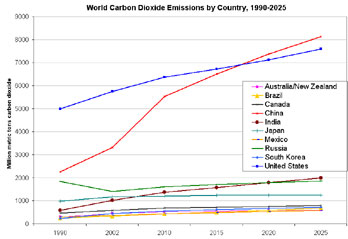 Venture Capitalists, China and Green Technology Venture Capitalists, China and Green Technology Tina Butler, mongabay.com May 24, 2006 A Bay Area venture capitalist with a storied past, has set his sights on “green technology” and ultimately China, after some compelling remarks from state representatives at a recent conference. Early this spring, Chinese officials named solar […]
Venture Capitalists, China and Green Technology Venture Capitalists, China and Green Technology Tina Butler, mongabay.com May 24, 2006 A Bay Area venture capitalist with a storied past, has set his sights on “green technology” and ultimately China, after some compelling remarks from state representatives at a recent conference. Early this spring, Chinese officials named solar […]
Largest solar power plant in a generation to be built in Nevada
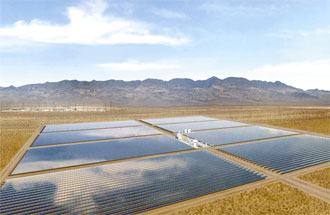 Largest solar power plant in a generation to be built in Nevada Largest solar power plant in a generation to be built in Nevada Rhett A. Butler, mongabay.com February 9, 2006 The groundbreaking for the largest solar thermal power plant to be built in 15 years takes place this weekend in Boulder City, Nevada. The […]
Largest solar power plant in a generation to be built in Nevada Largest solar power plant in a generation to be built in Nevada Rhett A. Butler, mongabay.com February 9, 2006 The groundbreaking for the largest solar thermal power plant to be built in 15 years takes place this weekend in Boulder City, Nevada. The […]
California adopts massive solar energy project
 California adopts massive solar energy project California adopts massive solar energy project Rhett A. Butler, mongabay.com January 13, 2005 The California Public Utilities Commission approved a $2.9 billion program to make the state one of the world’s largest producers of solar power. The plan would add 3,000 megawatts of solar energy over 11 years through […]
California adopts massive solar energy project California adopts massive solar energy project Rhett A. Butler, mongabay.com January 13, 2005 The California Public Utilities Commission approved a $2.9 billion program to make the state one of the world’s largest producers of solar power. The plan would add 3,000 megawatts of solar energy over 11 years through […]
Nanocrystals could boost photovoltaic solar energy technologies
Nanocrystals could boost photovoltaic solar energy technologies Nanocrystals could boost photovoltaic solar energy technologies Los Alamos National Laboratory January 4, 2006 Los Alamos National Laboratory scientists have discovered that a phenomenon called carrier multiplication, in which semiconductor nanocrystals respond to photons by producing multiple electrons, is applicable to a broader array of materials that previously […]
California plans $3 billion for solar energy projects
 California plans $3 billion for solar energy projects California plans $3 billion for solar energy projects Rhett A. Butler, mongabay.com December 13, 2005 Tuesday the California Public Utilities Commission announced an ambitious program to expand the market for solar power, proposing to provide $2.8 billion of incentives toward solar development over the next 11 years. […]
California plans $3 billion for solar energy projects California plans $3 billion for solar energy projects Rhett A. Butler, mongabay.com December 13, 2005 Tuesday the California Public Utilities Commission announced an ambitious program to expand the market for solar power, proposing to provide $2.8 billion of incentives toward solar development over the next 11 years. […]
Disposable solar panels developed using nanotechnology
Disposable solar panels developed using nanotechnology Disposable solar panels developed using nanotechnology University of Cape Town news release November 21, 2005 Scientists at the University of Cape Town are exploiting the nano-scale properties of silicon to develop a super-thin disposable solar panel poster which they hope could offer rural dwellers a cheap, alternative source of […]
Solar projects in California desert could help state’s energy problems
Solar power projects in California desert could help state’s energy problems Solar projects in California desert could help state’s energy problems Rhett A. Butler, mongabay.com November 17, 2005 Two large solar projects in the desert of California could boost industrial-scale development of solar technology according to an article in today’s edition of The Wall Street […]
Photovoltaic solar energy conversion can be cost-competitive by 2030
Photovoltaic solar energy conversion can be cost-competitive by 2030 Photovoltaic solar energy conversion can be cost-competitive by 2030 Australian National University release November 16, 2005 Professor Andrew Blakers from The Centre for Sustainable Energy Systems at the Australian National University will today report to the Greenhouse 2000 Conference in Melbourne that photovoltaic (PV) solar energy […]
Organic solar cells will help spur viability of alternative energy
Organic solar cells will help spur viability of alternative energy Organic solar cells will help spur viability of alternative energy by Mary Benanti New Mexico State University news release October 10, 2005 SANTA FE — Imagine being able to “paint” your roof with enough alternative energy to heat and cool your home. What if soldiers […]
High oil prices make Asia pursue green energy
 High oil prices make Asia pursue green energy High oil prices make Asia pursue green energy By David Fogarty Reuters September 9, 2005 For energy-hungry Asian governments, the answer could literally be blowing in the wind. Across the region, renewable energy such as solar, wind and geothermal power is gaining ever greater credence as a […]
High oil prices make Asia pursue green energy High oil prices make Asia pursue green energy By David Fogarty Reuters September 9, 2005 For energy-hungry Asian governments, the answer could literally be blowing in the wind. Across the region, renewable energy such as solar, wind and geothermal power is gaining ever greater credence as a […]
Renewable energy in China, a strategic future?
 Renewable energy in China, a strategic future? Renewable energy in China, a strategic future? Rhett Butler August 2, 2005 With a host of environmental and domestic social concerns — and potential future international conflict — China could be well suited to pursue renewable energy sources. China’s failed bid for American petroleum firm Unocal may prompt […]
Renewable energy in China, a strategic future? Renewable energy in China, a strategic future? Rhett Butler August 2, 2005 With a host of environmental and domestic social concerns — and potential future international conflict — China could be well suited to pursue renewable energy sources. China’s failed bid for American petroleum firm Unocal may prompt […]
Feeds: news | india | latam | brasil | indonesia
 GoSol.org’s work in Mexico Modern environmental crises of global resources often threaten both human health as well as biodiversity. Many of these concerns have consistently escaped remediation by public health institutions and mainstream environmental organizations. The compounding severity of these threats requires solutions that are cheap, local, scalable, easily replicated and immediately beneficial to local […]
GoSol.org’s work in Mexico Modern environmental crises of global resources often threaten both human health as well as biodiversity. Many of these concerns have consistently escaped remediation by public health institutions and mainstream environmental organizations. The compounding severity of these threats requires solutions that are cheap, local, scalable, easily replicated and immediately beneficial to local […] The U.S. Environmental Protection Agency’s (EPA) June 2nd regulation proposal hit all the expected chords. Following on the heels of a January regulation for new power plants, the Clean Power Plan focuses on all existing electric generation. By 2030, the plan aims to reduce 2005-level carbon dioxide emissions by 30 percent and soot and smog-causing […]
The U.S. Environmental Protection Agency’s (EPA) June 2nd regulation proposal hit all the expected chords. Following on the heels of a January regulation for new power plants, the Clean Power Plan focuses on all existing electric generation. By 2030, the plan aims to reduce 2005-level carbon dioxide emissions by 30 percent and soot and smog-causing […] For decades, scientists have been grappling with the consequences of climate change and working toward viable solutions. Climate engineering, also known as geoengineering, is the most controversial possible solution. Currently, one of the most talked about geoengineering ideas is Solar Radiation Management (SRM), which intends to block shortwave solar radiation, thus cooling the Earth to […]
For decades, scientists have been grappling with the consequences of climate change and working toward viable solutions. Climate engineering, also known as geoengineering, is the most controversial possible solution. Currently, one of the most talked about geoengineering ideas is Solar Radiation Management (SRM), which intends to block shortwave solar radiation, thus cooling the Earth to […] Solar Photovoltaic Projects: In the Mainstream Power Market, written by renewables energy pioneer Philip Wolfe, is an excellent introduction to the solar photovoltaic project development and power markets sector. Mr. Wolfe’s multi-decadal experience in the solar sector first founding BP Solar in the 1970s and then later working with various renewable energy finance initiatives, brings […]
Solar Photovoltaic Projects: In the Mainstream Power Market, written by renewables energy pioneer Philip Wolfe, is an excellent introduction to the solar photovoltaic project development and power markets sector. Mr. Wolfe’s multi-decadal experience in the solar sector first founding BP Solar in the 1970s and then later working with various renewable energy finance initiatives, brings […] Solar power on Nellis Air Force Base in Nevada. Photo by: U.S. Air Force photo/Airman 1st Class Nadine Y. Barclay. The world’s installed solar capacity hit 101 gigawatts last year, according to new data from the European Photovoltaic Industry Association (EPIA). Last year alone, saw nearly 30 gigawatts of solar power added around the world. […]
Solar power on Nellis Air Force Base in Nevada. Photo by: U.S. Air Force photo/Airman 1st Class Nadine Y. Barclay. The world’s installed solar capacity hit 101 gigawatts last year, according to new data from the European Photovoltaic Industry Association (EPIA). Last year alone, saw nearly 30 gigawatts of solar power added around the world. […] Electricity supplied from a new wind farm is cheaper than that from a new gas or coal-fired power plant in Australia, reports a new analysis published by Bloomberg New Energy Finance. According to the study, wind-generated electricity costs AU$80 ($83) per megawatt hour compared with compared to AU$143/MWh ($148) from a new coal plant or […]
Electricity supplied from a new wind farm is cheaper than that from a new gas or coal-fired power plant in Australia, reports a new analysis published by Bloomberg New Energy Finance. According to the study, wind-generated electricity costs AU$80 ($83) per megawatt hour compared with compared to AU$143/MWh ($148) from a new coal plant or […] In 1990, British cloud physicist John Latham published a paper arguing he could cool global climate by brightening clouds over the ocean. Most colleagues ignored the paper, titled “Control global warming?”—probably because this thing called global warming was not yet a hot topic. Now, more than two decades later, Latham continues to develop what has […]
In 1990, British cloud physicist John Latham published a paper arguing he could cool global climate by brightening clouds over the ocean. Most colleagues ignored the paper, titled “Control global warming?”—probably because this thing called global warming was not yet a hot topic. Now, more than two decades later, Latham continues to develop what has […] The ongoing decline in Arctic sea ice hit a new record this year that rocked even the most pessimistic predictions. The low sea ice extent hit 18 percent below the previous record set in just 2007, and was only around half the size it was in 1980. Here, NASA satellites catches a glimpse of the […]
The ongoing decline in Arctic sea ice hit a new record this year that rocked even the most pessimistic predictions. The low sea ice extent hit 18 percent below the previous record set in just 2007, and was only around half the size it was in 1980. Here, NASA satellites catches a glimpse of the […] Surface coal mining in Bihar, India. Around 70-80 percent of India’s power is currently provided by coal. Burning coal fuels climate change, causes acid rain, and spreads toxic pollutants into the environment, but now a new Greenpeace report warns that coal may also imperil the world’s biggest feline: the tiger. Home to world’s largest population […]
Surface coal mining in Bihar, India. Around 70-80 percent of India’s power is currently provided by coal. Burning coal fuels climate change, causes acid rain, and spreads toxic pollutants into the environment, but now a new Greenpeace report warns that coal may also imperil the world’s biggest feline: the tiger. Home to world’s largest population […] Imagine powering your cell phone by leaving it on the window sill. Sounds like science fiction? Actually, this might soon turn into reality. Scientists have been exploring the potential of solar energy for decades. One of the cheapest ways to turn solar energy into electricity is by creating solar cells from organic polymers, which are […]
Imagine powering your cell phone by leaving it on the window sill. Sounds like science fiction? Actually, this might soon turn into reality. Scientists have been exploring the potential of solar energy for decades. One of the cheapest ways to turn solar energy into electricity is by creating solar cells from organic polymers, which are […] As many people in the United States question whether renewable energy is a viable alternative to fossil fuels, Germany now derives 20.8 percent of its electricity from renewable sources—a 15 percent increase since 2000, reports Der Spiegel. In contrast, the United States generates only 10 percent of its electricity from renewable sources, 6 percent of […]
As many people in the United States question whether renewable energy is a viable alternative to fossil fuels, Germany now derives 20.8 percent of its electricity from renewable sources—a 15 percent increase since 2000, reports Der Spiegel. In contrast, the United States generates only 10 percent of its electricity from renewable sources, 6 percent of […] Recent studies point to the feasibility of a global clean energy revolution. Last night US President Barack Obama called for a massive green energy make-over of the world’s largest economy. Describing the challenge as ‘this generation’s Sputnik moment’ the US president set a goal of producing 80 percent of America’s energy by clean sources by […]
Recent studies point to the feasibility of a global clean energy revolution. Last night US President Barack Obama called for a massive green energy make-over of the world’s largest economy. Describing the challenge as ‘this generation’s Sputnik moment’ the US president set a goal of producing 80 percent of America’s energy by clean sources by […] The U.S. Department of Energy has finalized a guarantee to provide a loan of $1.45 billion to Abengoa Solar Inc. which will fund the world’s largest parabolic trough concentrating solar plant. The plant is expected to serve 70,000 households and avoid 475,000 tons of carbon dioxide emissions per year. The plant, called Solana, will be […]
The U.S. Department of Energy has finalized a guarantee to provide a loan of $1.45 billion to Abengoa Solar Inc. which will fund the world’s largest parabolic trough concentrating solar plant. The plant is expected to serve 70,000 households and avoid 475,000 tons of carbon dioxide emissions per year. The plant, called Solana, will be […] There is no question that governments around the world are moving slowly and sluggishly to combat climate change, especially when placed against the measures recommended by climate scientists. Only a handful of nations have actually cut overall greenhouse gas emissions, and the past couple decades have seen emissions rise rapidly worldwide as nations like India […]
There is no question that governments around the world are moving slowly and sluggishly to combat climate change, especially when placed against the measures recommended by climate scientists. Only a handful of nations have actually cut overall greenhouse gas emissions, and the past couple decades have seen emissions rise rapidly worldwide as nations like India […] This year China has become the world’s largest manufacturer of solar panels and wind turbines, doubling its wind capacity since 2005. The economically booming nation—and the world’s most populous—has also invested heavily in nuclear power and the world’s most efficient coal plants, according to the New York Times. Still, even with massive investments in green […]
This year China has become the world’s largest manufacturer of solar panels and wind turbines, doubling its wind capacity since 2005. The economically booming nation—and the world’s most populous—has also invested heavily in nuclear power and the world’s most efficient coal plants, according to the New York Times. Still, even with massive investments in green […] During the fiscal years of 2002-2008 the United States handed out subsidies to fossil fuel industries to a tune of 72 billion dollars, while renewable energy subsidies, during the same period, reached 29 billion dollars. Conducted by the Environmental Law Institute (ELI) in partnership with the Woodrow Wilson International Center for Scholars, the research shows […]
During the fiscal years of 2002-2008 the United States handed out subsidies to fossil fuel industries to a tune of 72 billion dollars, while renewable energy subsidies, during the same period, reached 29 billion dollars. Conducted by the Environmental Law Institute (ELI) in partnership with the Woodrow Wilson International Center for Scholars, the research shows […]
 Whether oil is succeeded by coal or renewables will have major impact on climate The world must phase out emissions from coal by 2030 to avert dangerous climate change, said scientists speaking at the annual meeting of the American Geophysical Union in San Francisco. Arguing that the planet will face environmental constraints well before fossil […]
Whether oil is succeeded by coal or renewables will have major impact on climate The world must phase out emissions from coal by 2030 to avert dangerous climate change, said scientists speaking at the annual meeting of the American Geophysical Union in San Francisco. Arguing that the planet will face environmental constraints well before fossil […] Obama may bring leadership, rather than obstruction, to climate change talks Obama may bring leadership, rather than obstruction, to climate change talks mongabay.com November 6, 2008
Obama may bring leadership, rather than obstruction, to climate change talks Obama may bring leadership, rather than obstruction, to climate change talks mongabay.com November 6, 2008 PG&E will build the world’s largest solar power plant PG&E will build the world’s largest solar power plant mongabay.com August 15, 2008 California electricity producer PG&E Thursday announced a plan to build two giant solar photovoltaic power plants that will cover 12.5 square miles and have a peak generating capacity of 800 megawatts. The plants […]
PG&E will build the world’s largest solar power plant PG&E will build the world’s largest solar power plant mongabay.com August 15, 2008 California electricity producer PG&E Thursday announced a plan to build two giant solar photovoltaic power plants that will cover 12.5 square miles and have a peak generating capacity of 800 megawatts. The plants […] Gore launches second campaign… for Earth Gore launches second campaign mongabay.com July 17, 2008 In a speech Thursday, Al Gore challenged the U.S. to generate 100 percent of its electricity from zero carbon emission sources within 10 years. Speaking at Washington’s Constitution Hall, Gore said America’s security, environmental and economic crises are all related, and […]
Gore launches second campaign… for Earth Gore launches second campaign mongabay.com July 17, 2008 In a speech Thursday, Al Gore challenged the U.S. to generate 100 percent of its electricity from zero carbon emission sources within 10 years. Speaking at Washington’s Constitution Hall, Gore said America’s security, environmental and economic crises are all related, and […] Breakthrough in solar energy: ten times more effective solar power may be available in three years Breakthrough in solar energy: ten times more effective solar power may be available in three years Jeremy Hance, mongabay.com July 10, 2008 The breakthrough scientists have been waiting for to make solar power cheaper, more efficient–and therefore a more […]
Breakthrough in solar energy: ten times more effective solar power may be available in three years Breakthrough in solar energy: ten times more effective solar power may be available in three years Jeremy Hance, mongabay.com July 10, 2008 The breakthrough scientists have been waiting for to make solar power cheaper, more efficient–and therefore a more […] Clean energy investments rose 60% to $148 billion in 2007 Clean energy gold rush in 2007 mongabay.com July 1, 2008 New investment in renewables and energy efficiency surpassed $148 billion in 2007, rising 60 percent rise from 2006, according to an analysis issued Tuesday July 1 by the UN Environment Programme (UNEP). High oil prices […]
Clean energy investments rose 60% to $148 billion in 2007 Clean energy gold rush in 2007 mongabay.com July 1, 2008 New investment in renewables and energy efficiency surpassed $148 billion in 2007, rising 60 percent rise from 2006, according to an analysis issued Tuesday July 1 by the UN Environment Programme (UNEP). High oil prices […] New World Record for Solar-to-Grid Conversion Efficiency New World Record for Solar-to-Grid Conversion Efficiency mongabay.com February 13, 2008 Sandia National Laboratories and Stirling Energy Systems (SES) set a new solar-to-grid system conversion efficiency record by achieving a 31.25 percent net efficiency, nearly a 2 point gain of the previous record of 29.4 percent set in […]
New World Record for Solar-to-Grid Conversion Efficiency New World Record for Solar-to-Grid Conversion Efficiency mongabay.com February 13, 2008 Sandia National Laboratories and Stirling Energy Systems (SES) set a new solar-to-grid system conversion efficiency record by achieving a 31.25 percent net efficiency, nearly a 2 point gain of the previous record of 29.4 percent set in […] Google aims to make renewable energy sources cheaper than coal Google aims to make renewable energy cheaper than coal mongabay.com November 28, 2007 Tuesday Google announced an initiative to develop electricity from renewable energy sources that will be cheaper than electricity produced from coal. The initiative, dubbed RE<C, will initially focus on solar, wind, and […]
Google aims to make renewable energy sources cheaper than coal Google aims to make renewable energy cheaper than coal mongabay.com November 28, 2007 Tuesday Google announced an initiative to develop electricity from renewable energy sources that will be cheaper than electricity produced from coal. The initiative, dubbed RE<C, will initially focus on solar, wind, and […] IBM finds recycling can cut solar cell manufacturing costs IBM finds recycling can cut solar cell manufacturing costs mongabay.com October 30, 2007 IBM today announced a silicon wafer recycling system that could help ease the refined silicon shortage that has driven up production costs of solar energy panels. The process allows efficient removal intellectual property […]
IBM finds recycling can cut solar cell manufacturing costs IBM finds recycling can cut solar cell manufacturing costs mongabay.com October 30, 2007 IBM today announced a silicon wafer recycling system that could help ease the refined silicon shortage that has driven up production costs of solar energy panels. The process allows efficient removal intellectual property […] Florida to cut greenhouse gas emissions 80% by 2050 Florida to cut greenhouse gas emissions 80% by 2050 mongabay.com July 15, 2007 Florida plans to cut greenhouse gas emissions 80 percent from 1990 levels by 2050 according to Charlie Crist, Florida’s Republican state governor. Due to its low elevation and hurricane risk, global warming may […]
Florida to cut greenhouse gas emissions 80% by 2050 Florida to cut greenhouse gas emissions 80% by 2050 mongabay.com July 15, 2007 Florida plans to cut greenhouse gas emissions 80 percent from 1990 levels by 2050 according to Charlie Crist, Florida’s Republican state governor. Due to its low elevation and hurricane risk, global warming may […] Inflatable concentrators may cut cost of solar below conventional power plants Inflatable concentrators may cut cost of solarbelow conventional power plants Rhett A. Butler, mongabay.com July 8, 2007 Cool Earth Solar, a Livermore, California-based company developing an innovative way for capturing solar energy, has merged with Radiant Energy, a developer and owner of renewable and […]
Inflatable concentrators may cut cost of solar below conventional power plants Inflatable concentrators may cut cost of solarbelow conventional power plants Rhett A. Butler, mongabay.com July 8, 2007 Cool Earth Solar, a Livermore, California-based company developing an innovative way for capturing solar energy, has merged with Radiant Energy, a developer and owner of renewable and […] Cuban Energy Crisis Solved Cuba Energy Crisis Solved By Joshua S Hill July 5, 2007 Cuba may be overcoming its intermittent energy crisis, according to a top U.N. official. Power shortages and brownouts have long been a problem in the small communist island nation, but it was daily 16 hour-electricity cuts in 2004 that finally […]
Cuban Energy Crisis Solved Cuba Energy Crisis Solved By Joshua S Hill July 5, 2007 Cuba may be overcoming its intermittent energy crisis, according to a top U.N. official. Power shortages and brownouts have long been a problem in the small communist island nation, but it was daily 16 hour-electricity cuts in 2004 that finally […] Google to be carbon neutral by year end Google to be carbon neutral by year end mongabay.com June 20, 2007 Google Inc. aims to be carbon neutral by the end of 2007, according to a statement posted on the Official Google Blog. The search giant plans to fight global warming by investing in and using […]
Google to be carbon neutral by year end Google to be carbon neutral by year end mongabay.com June 20, 2007 Google Inc. aims to be carbon neutral by the end of 2007, according to a statement posted on the Official Google Blog. The search giant plans to fight global warming by investing in and using […] $100 billion invested in renewable energy in 2006 $100 billion invested in renewable energy in 2006 mongabay.com June 20, 2007 $100 billion poured into renewable energy and energy efficiency in 2006, a 25 percent jump from 2005, reports a new analysis by the UN Environment Programme (UNEP). UNEP anticipates the trend will slow to $85 […]
$100 billion invested in renewable energy in 2006 $100 billion invested in renewable energy in 2006 mongabay.com June 20, 2007 $100 billion poured into renewable energy and energy efficiency in 2006, a 25 percent jump from 2005, reports a new analysis by the UN Environment Programme (UNEP). UNEP anticipates the trend will slow to $85 […] Google will put $10M towards plug-in hybrid cars Google will put $10M towards plug-in hybrid cars Rhett A. Butler, mongabay.com June 19, 2007 Google.org, Google Inc.’s philanthropic arm, unveiled an initiative to convert hybrid cars to plug-in hybrid vehicles (PHEVs), a move that will cut carbon dioxide emissions, reduce oil use, and help stabilize the […]
Google will put $10M towards plug-in hybrid cars Google will put $10M towards plug-in hybrid cars Rhett A. Butler, mongabay.com June 19, 2007 Google.org, Google Inc.’s philanthropic arm, unveiled an initiative to convert hybrid cars to plug-in hybrid vehicles (PHEVs), a move that will cut carbon dioxide emissions, reduce oil use, and help stabilize the […] Nobel prize winner debates future of nuclear power Nobel prize winner debates future of nuclear power Rhett A. Butler, mongabay.com June 7, 2007 Two renowned energy experts sparred in a debate over nuclear energy Wednesday afternoon at Stanford University. Amory Lovins, Chairman and Chief Scientist of the Rocky Mountain Institute, an energy think tank, argued […]
Nobel prize winner debates future of nuclear power Nobel prize winner debates future of nuclear power Rhett A. Butler, mongabay.com June 7, 2007 Two renowned energy experts sparred in a debate over nuclear energy Wednesday afternoon at Stanford University. Amory Lovins, Chairman and Chief Scientist of the Rocky Mountain Institute, an energy think tank, argued […] Balloon technology could cut cost of solar energy 90% by 2010 Balloon technology could cut cost of solar energy 90% by 2010 Rhett A. Butler, mongabay.com February 21, 2007 With high energy prices and mounting concerns over human-induced climate change, there is intense interest in renewable energy, especially solar, which produces no pollution and is […]
Balloon technology could cut cost of solar energy 90% by 2010 Balloon technology could cut cost of solar energy 90% by 2010 Rhett A. Butler, mongabay.com February 21, 2007 With high energy prices and mounting concerns over human-induced climate change, there is intense interest in renewable energy, especially solar, which produces no pollution and is […] China to build world’s largest solar power plant China to build world’s largest solar power plant mongabay.com November 21, 2006 China plans to build the world’s largest solar power station in the northwestern province of Gansu according to a report from Xinhua, China’s state news agency. Construction of the 100 megawatt facility will take five […]
China to build world’s largest solar power plant China to build world’s largest solar power plant mongabay.com November 21, 2006 China plans to build the world’s largest solar power station in the northwestern province of Gansu according to a report from Xinhua, China’s state news agency. Construction of the 100 megawatt facility will take five […] Google worried about global warming? Google worried about global warming? Google to build largest solar-powered office in the U.S. mongabay.com October 17, 2006 Google said it plans to build a solar-powered electricity system at its Silicon Valley headquarters that will be the largest solar installation on any corporate campus in the United States. “Soon we […]
Google worried about global warming? Google worried about global warming? Google to build largest solar-powered office in the U.S. mongabay.com October 17, 2006 Google said it plans to build a solar-powered electricity system at its Silicon Valley headquarters that will be the largest solar installation on any corporate campus in the United States. “Soon we […] Solar Powers Makes Mainland China’s Richest Man Solar Energy Powers Mainland China’s Richest Man mongabay.com October 12, 2006 The largest private fortune in mainland China may belong to Shi Zhengrong, the founder of the China’s largest producer of photovoltaic equipment used to convert sunlight into electricity, according to an article in today’s edition of The […]
Solar Powers Makes Mainland China’s Richest Man Solar Energy Powers Mainland China’s Richest Man mongabay.com October 12, 2006 The largest private fortune in mainland China may belong to Shi Zhengrong, the founder of the China’s largest producer of photovoltaic equipment used to convert sunlight into electricity, according to an article in today’s edition of The […] Northern Ireland mandates green energy for new buildings Northern Ireland mandates green energy for new buildings Northern Ireland Office July 25, 2006 Green buildings may be the future for Northern Ireland The Government is proposing changes to the Building Regulations which will make the use of renewable energy compulsory in all new builds from 2008, […]
Northern Ireland mandates green energy for new buildings Northern Ireland mandates green energy for new buildings Northern Ireland Office July 25, 2006 Green buildings may be the future for Northern Ireland The Government is proposing changes to the Building Regulations which will make the use of renewable energy compulsory in all new builds from 2008, […] High school students compete in solar car race High school students compete in solar car race Modified news release from SCHOTT July 13, 2006 Powered by SCHOTT Solar Cells, Sundancer Makes Bid for 6th Consecutive Championship at Dell-Winston School Solar Car Challenge Beginning on July 16th, high school students from the US, Puerto Rico and […]
High school students compete in solar car race High school students compete in solar car race Modified news release from SCHOTT July 13, 2006 Powered by SCHOTT Solar Cells, Sundancer Makes Bid for 6th Consecutive Championship at Dell-Winston School Solar Car Challenge Beginning on July 16th, high school students from the US, Puerto Rico and […] Venture Capitalists, China and Green Technology Venture Capitalists, China and Green Technology Tina Butler, mongabay.com May 24, 2006 A Bay Area venture capitalist with a storied past, has set his sights on “green technology” and ultimately China, after some compelling remarks from state representatives at a recent conference. Early this spring, Chinese officials named solar […]
Venture Capitalists, China and Green Technology Venture Capitalists, China and Green Technology Tina Butler, mongabay.com May 24, 2006 A Bay Area venture capitalist with a storied past, has set his sights on “green technology” and ultimately China, after some compelling remarks from state representatives at a recent conference. Early this spring, Chinese officials named solar […] Largest solar power plant in a generation to be built in Nevada Largest solar power plant in a generation to be built in Nevada Rhett A. Butler, mongabay.com February 9, 2006 The groundbreaking for the largest solar thermal power plant to be built in 15 years takes place this weekend in Boulder City, Nevada. The […]
Largest solar power plant in a generation to be built in Nevada Largest solar power plant in a generation to be built in Nevada Rhett A. Butler, mongabay.com February 9, 2006 The groundbreaking for the largest solar thermal power plant to be built in 15 years takes place this weekend in Boulder City, Nevada. The […] California adopts massive solar energy project California adopts massive solar energy project Rhett A. Butler, mongabay.com January 13, 2005 The California Public Utilities Commission approved a $2.9 billion program to make the state one of the world’s largest producers of solar power. The plan would add 3,000 megawatts of solar energy over 11 years through […]
California adopts massive solar energy project California adopts massive solar energy project Rhett A. Butler, mongabay.com January 13, 2005 The California Public Utilities Commission approved a $2.9 billion program to make the state one of the world’s largest producers of solar power. The plan would add 3,000 megawatts of solar energy over 11 years through […] California plans $3 billion for solar energy projects California plans $3 billion for solar energy projects Rhett A. Butler, mongabay.com December 13, 2005 Tuesday the California Public Utilities Commission announced an ambitious program to expand the market for solar power, proposing to provide $2.8 billion of incentives toward solar development over the next 11 years. […]
California plans $3 billion for solar energy projects California plans $3 billion for solar energy projects Rhett A. Butler, mongabay.com December 13, 2005 Tuesday the California Public Utilities Commission announced an ambitious program to expand the market for solar power, proposing to provide $2.8 billion of incentives toward solar development over the next 11 years. […] High oil prices make Asia pursue green energy High oil prices make Asia pursue green energy By David Fogarty Reuters September 9, 2005 For energy-hungry Asian governments, the answer could literally be blowing in the wind. Across the region, renewable energy such as solar, wind and geothermal power is gaining ever greater credence as a […]
High oil prices make Asia pursue green energy High oil prices make Asia pursue green energy By David Fogarty Reuters September 9, 2005 For energy-hungry Asian governments, the answer could literally be blowing in the wind. Across the region, renewable energy such as solar, wind and geothermal power is gaining ever greater credence as a […] Renewable energy in China, a strategic future? Renewable energy in China, a strategic future? Rhett Butler August 2, 2005 With a host of environmental and domestic social concerns — and potential future international conflict — China could be well suited to pursue renewable energy sources. China’s failed bid for American petroleum firm Unocal may prompt […]
Renewable energy in China, a strategic future? Renewable energy in China, a strategic future? Rhett Butler August 2, 2005 With a host of environmental and domestic social concerns — and potential future international conflict — China could be well suited to pursue renewable energy sources. China’s failed bid for American petroleum firm Unocal may prompt […]